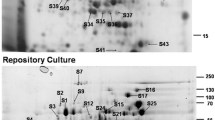Abstract
The pathogenicity ofNocardia caviae, N. asteroides andN. brasiliensis has been tested for white mice, guinea pigs and rabbits and chorio-allantoic membrane of the developing chick embryo. Altogether, 14 strains belonging to the 3Nocardia species originating from soil, human and animal sources in India or abroad were tested. All of them proved pathogenic though the degree of virulence varied from strain to strain. Incorporation of hog gastric mucin in the inoculum enhanced the virulence of all the 3Nocardia species for white mice.N. caviae strains were uniformly more virulent than those ofN. asteroides andN. brasiliensis.
In the white mice inoculated intraperitoneally, a greater dissemination of the disease was apparent withN. caviae than withN. asteroides. Of the 6 strains ofN. caviae tested, 5 disseminated to the lung, 3 to the heart and 2 to the brain. InN. asteroides dissemination of the disease to the brain was observed with 2 of its 3 strains.N. brasiliensis showed no dissemination.N. caviae was found to be equally virulent for white mice, guinea pigs and rabbits. On the other hand,N. asteroides andN. brasiliensis were more virulent for white mice than for guinea pigs and rabbits. The lesions caused byN. caviae in mice, guinea pigs and rabbits persisted up to 4 weeks. In strong contrast to this the lesions due toN. asteroides andN. brasiliensis found in the guinea pigs and rabbits showed a strong tendency towards spontaneous clearance.
Histologically, the lesions caused byN. caviae, N. asteroides andN. brasiliensis in mice, guinea pigs and rabbits were in the form of abscesses which showed an acute or chronic reaction. In the case ofN. caviae these abscesses showed both granules and freely dispersed cocco-bacillary bodies or filaments. As forN. asteroides it occurred in the form of cocco-bacillary bodies or filaments whereasN. brasiliensis consistently produced granules in the lesions.
The lesions caused by the 3Nocardia species on the chorio-allantoic membrane of the developing chick embryo were in the form of abscesses which contained cocco-bacillary bodies and branching filaments but no granules.
Similar content being viewed by others
References
Brizin, B. &Lenart, I. (1957) Experimental nocardiosis in white mice.Acta Med. Jugoslav. 11:292–297.
Cruickshank, R. (1962) Mackie & McCartney's Handbook of Bacteriology. E. & S. Livingstone Ltd., Edinburgh. 10th Edition, p. 214.
Destombes, P., Mariat, F., Nazimoff, O. &Satre, J. (1961) A propos des mycetomes aNocardia.Sabouraudia 1:161–172.
Drake, C. H. &Henrici, A. T. (1943)Nocardia asteroides, its pathogenicity and allergic properties.Amer. Rev. Tuberc. 48:184–198.
Emmons, C. W., Binford, C. H., &Utz, J. P. (1963) Medical Mycology. Lea and Febiger. Philadelphia. p. 366.
Eppinger, H. L. (1890) Über eine neue pathogeneCladothrix und eine durch sie hervorgerufene pseudotuberkulosie (Cladothrichica).Beitr. Pathol. Anat. allgem. Pathol. 9:287–328; cited afterAinsworth, G. C. &Austwick, P.K.C. 1959. “Fungal diseases of animals.” Farnham Royal, Bucks, England.
Forbus, W. D., Fukynaga, N., Van Schoote, A. &Cress, H. (1960) Reaction of chorio-allantoic membrane of chick embryo toNocardia intracellularis inoculation.AMA Arch. Path. 69:571–577.
Georg, L. K., Ajello, L., McDermont, C. &Hosty, T. S. (1961) The identification ofN. asteroides andN. brasiliensis.Amer. Rev. Resp. Dis. 84:337–347.
Goyal, R. K. (1937) Etude microbiologique expérimentale et immunologique des quelques Streptothrices.Ann. Inst. Pasteur 59:94–128.
Kurup, P. V. &Sandhu, R. S. (1965) Isolation ofNocardia caviae from soil and its pathogenicity for laboratory animals.J. Bacteriol. 90:822–823.
MacCallum, W. G. (1902) On the life history ofActinomyces asteroides.Center. Bakteriol. Parasitenk. Org. 31:528–547. Cited afterWaksman, 1959. Actinomycetes. Vol. 1. Williams & Wilkins Co.
Mackinnon, J. E. &Artagaveytia-Allende, R. (1956) The main species of pathogenic aerobic actinomycetes causing mycetomas.Trans. Roy. Soc. Trop. Med. Hyg. 50:31–40.
Macotelia-Ruiz, E. &Mariat, F. (1963) Sur la production de mycetoma expérimentaux parNocardia brasiliensis etNocardia asteroides.Bull. Soc. Path. Exot. 89:426–431.
Mohapatra, L. N. &Pine, L. (1963) Studies on the pathogenicity of aerobic actinomycetes inoculated into mice intravenously.Sabouraudia 2:176–184.
Pegrum, G. D. (1964) Actinomycotic lesions in the chorio-allantoic membrane of the chick embryo.J. Path. Bact. 88:323–326.
Pizzoli, A. (1961) Characteres deNocardia asteroides yNocardia brasiliensis cultivos y en los tejidos.An. Fac. Med. Montevideo. 46:29–36.
Runyon, E. H. (1951)Nocardia asteroides, studies of its pathogenicity and drug sensitivities.J. Lab. Clin. Med. 37:713–720.
Strauss, R. E. &Kligman, A. M. (1951) The use of gastric mucin to lower the resistance of laboratory animals to systemic fungus infection.J. Infect. Dis. 58:151–155.
Author information
Authors and Affiliations
Additional information
This forms a part of the thesis submitted by P.V.K. for Ph. D. degree, of the University of Delhi.
Rights and permissions
About this article
Cite this article
Kurup, P.V., Randhawa, H.S., Sandhu, R.S. et al. Pathogenicity of Nocardia caviae, N. asteroides and N. brasiliensis. Mycopathologia et Mycologia Applicata 40, 113–130 (1970). https://doi.org/10.1007/BF02051989
Accepted:
Issue Date:
DOI: https://doi.org/10.1007/BF02051989




